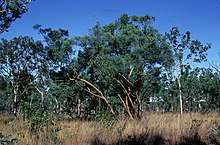Eucalyptus lirata
Eucalyptus lirata, commonly known as Kimberley yellowjacket,[2] is a species of small tree or mallee that is endemic to the Kimberley region of Western Australia. It has rough, fibrous bark on the trunk and most of the branches, lance-shaped or curved adult leaves, flower buds arranged in groups of three, white flowers and cylindrical to cup-shaped fruit.
| Kimberley yellowjacket | |
|---|---|
 | |
| Eucalyptus lirata at Gibb River Station | |
| Scientific classification | |
| Kingdom: | Plantae |
| Clade: | Tracheophytes |
| Clade: | Angiosperms |
| Clade: | Eudicots |
| Clade: | Rosids |
| Order: | Myrtales |
| Family: | Myrtaceae |
| Genus: | Eucalyptus |
| Species: | E. lirata |
| Binomial name | |
| Eucalyptus lirata | |
Description
Eucalyptus lirata is a small tree or mallee that typically grows to a height of 3 to 8 metres (10 to 26 ft) and forms a lignotuber. It has rough, brownish, fibrous or flaky bark on the trunk and most of the branches. Young plants and coppice regrowth have egg-shaped to elliptic leaves that are 45–95 mm (1.8–3.7 in) long, 24–60 mm (0.94–2.36 in) wide. The adult leaves are lance-shaped or curved, the same, or a slightly different shade, of dull bluish or yellowish green on both sides, 65–140 mm (2.6–5.5 in) long and 7–26 mm (0.28–1.02 in) wide, tapering to a petiole 6–20 mm (0.24–0.79 in) long. The flower buds are arranged in leaf axils in groups of three on an unbranched peduncle 5–8 mm (0.20–0.31 in) long, the individual buds on pedicels 1–4 mm (0.039–0.157 in) long. Mature buds are cylindrical, 7–11 mm (0.28–0.43 in) long and 4–5 mm (0.16–0.20 in) wide with a conical to rounded operculum. Flowering occurs from September to January and the flowers are white. The fruit is a woody, cylindrical to cup-shaped capsule 7–11 mm (0.28–0.43 in) long and 5–10 mm (0.20–0.39 in) wide with the valves near rim level.[3][4]
Taxonomy and naming
Eucalyptus lirata was first formally described in 1921 by Joseph Maiden in his book A Critical Revision of the Genus Eucalyptus.[5][6] The specific epithet (liratus) is from the Latin word lira meaning "furrowed" with the ending -atus indicating possession, probably referring to the bark.[7]
Distribution and habitat
The Kimberley leatherjacket grows on ridges, rises and plateaux as scattered trees or in woodland in the Kimberley region.[2][4]
Conservation status
This eucalypt is classified as "not threatened" by the Western Australian Government Department of Parks and Wildlife.[2]
See also
References
- "Eucalyptus lirata". Australian Plant Census. Retrieved 15 September 2019.
- "Eucalyptus lirata". FloraBase. Western Australian Government Department of Parks and Wildlife.
- "Eucalyptus lirata". Euclid: Centre for Australian National Biodiversity Research. Retrieved 1 June 2020.
- Chippendale, George M. "Eucalyptus lirata". Australian Biological Resources Study, Department of the Environment and Energy, Canberra. Retrieved 15 September 2019.
- "Eucalyptus lirata". APNI. Retrieved 15 September 2019.
- Maiden, Joseph (1921). A Critical Revision of the Genus Eucalyptus. Sydney: New South Wales Government Printer. pp. 111–112. Retrieved 15 September 2019.
- Francis Aubie Sharr (2019). Western Australian Plant Names and their Meanings. Kardinya, Western Australia: Four Gables Press. p. 241. ISBN 9780958034180.